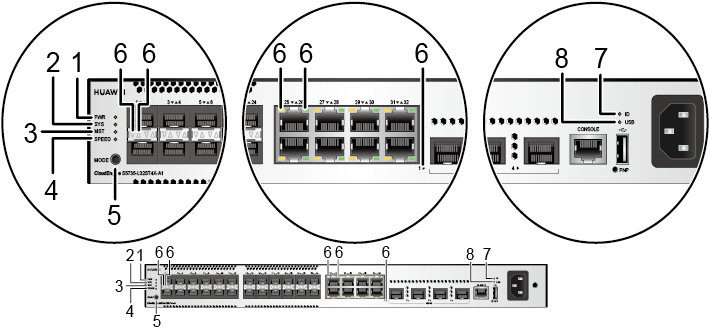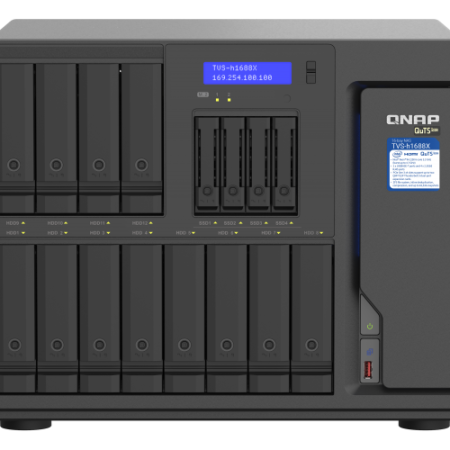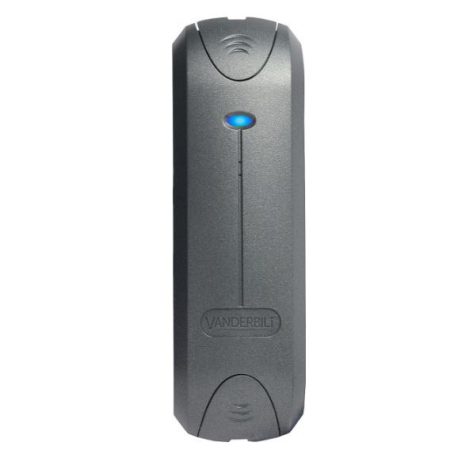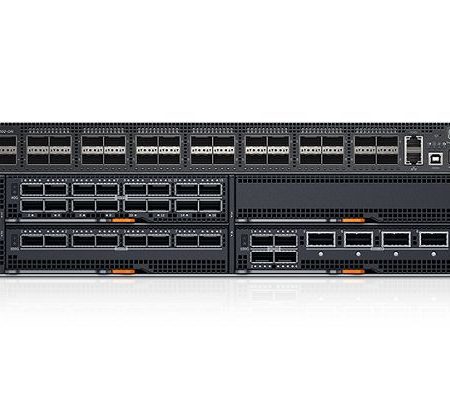S5735-L32ST4X-A1
Overview
| Item | Details |
|---|---|
| Description | S5735-L32ST4X-A1 (24*GE SFP ports, 8*10/100/1000BASE-T ports, 4*10GE SFP+ ports, AC power, front access) |
| Part Number | 98011396 |
| Model | S5735-L32ST4X-A1 |
| First supported version | V200R020C10 |
Components

|
1 |
Twenty-four 100/1000BASE-X ports |
2 |
Eight 10/100/1000BASE-T ports |
|
3 |
Four 10GE SFP+ ports |
4 |
One console port |
|
5 |
One USB port |
6 |
One PNP button NOTICE:
To restore the factory settings and reset the switch, hold down the button for at least 6 seconds. To reset the switch, press the button. Resetting the switch will cause service interruption. Exercise caution when you press the PNP button. |
|
7 |
AC socket NOTE:
It is used with an AC power cable. |
8 |
Jack for AC power cable locking strap NOTE:
The AC power cable locking strap is not delivered with the switch.
|
|
9 |
Ground screw NOTE:
It is used with a ground cable.
|
– |
– |
Ports
| Port | Connector Type | Description | Available Components |
|---|---|---|---|
| 10/100/1000BASE-T port | RJ45 | A 10/100/1000BASE-T Ethernet electrical port sends and receives service data at 10/100/1000 Mbit/s. | |
| 100/1000BASE-X port | SFP | A 100/1000BASE-X port can send and receive data at 100 Mbit/s or 1000 Mbit/s. | |
| 10GE SFP+ optical port | SFP+ | A 10GE SFP+ Ethernet optical port supports auto-sensing to 1000 Mbit/s. It sends and receives service data at 1000 Mbit/s or 10 Gbit/s. |
|
| Console port | RJ45 | The console port is connected to a console for on-site configuration. | |
| USB port | USB 2.0 Type A |
The USB port can have a USB flash drive connected to upgrade the switch, or transfer configuration files or other files. The USB port can only connect to a USB flash drive that complies with USB 2.0. USB flash drives from different vendors differ in model compatibility and drivers. If a USB flash drive cannot be used, try to replace it with another one from a mainstream vendor. Switches support a maximum of 128 GB USB flash drives. |
USB flash drive |
Indicators and Buttons

|
No. |
Indicator |
Name |
Color |
Status |
Description |
|---|---|---|---|---|---|
|
1 |
PWR |
Power module indicator |
– |
Off |
The switch is powered off. |
|
Green |
Steady on |
The system power supply is normal. |
|||
|
2 |
SYS |
System status indicator |
– |
Off |
The system is not running. |
|
Green |
Fast blinking |
The system is starting. |
|||
|
Green |
Steady on |
During the system startup preparation phase, the SYS indicator is steady green, which lasts for a maximum of 30 seconds. |
|||
|
Green |
Slow blinking |
The system is running normally. |
|||
|
Red |
Steady on |
The system does not work normally after registration, or a fan alarm or a temperature alarm has been generated. |
|||
|
3 |
MST |
Stack indicator |
– |
Off |
|
|
Green |
Steady on |
The stack mode is selected. The switch is a standby or slave switch in a stack, and the service port indicators show the stack ID of the switch. |
|||
|
Green |
Blinking |
|
|||
|
4 |
SPEED |
Speed indicator |
– |
Off |
The speed mode is not selected. |
|
Green |
Steady on |
The speed mode is selected, and service port indicators show the speed of each port. |
|||
|
5 |
MODE |
Mode switch button |
– |
– |
If you do not press the MODE button within 45 seconds, the service port indicators restore to the default mode. In this case, the SPEED indicator is off. NOTE:
Hold down the mode switch button for 6s and release it to start the web initial login mode. Either of the following situations will occur:
|
|
6 |
– |
Service port indicator |
Meanings of service port indicators vary in different modes. For details, see Table 4-1526 and Table 4-1527. NOTE:
If a power failure occurs on a device’s PCB board, indicators of the last four optical ports on the device’s front panel blink green cyclically at an interval of 1 second, with each indicator illuminating for 0.25 seconds. |
||
|
7 |
ID |
ID indicator |
– |
Off |
The ID indicator is not used (default state). |
|
Blue |
Steady on |
The indicator identifies the switch to maintain. The ID indicator can be turned on or off remotely to help field engineers find the switch to maintain. |
|||
|
8 |
USB |
USB-based deployment indicator |
– |
Off |
|
|
Green |
Steady on |
A USB-based deployment has been completed. |
|||
|
Green |
Fast blinking |
The system is reading data from a USB flash drive. |
|||
|
Green |
Slow blinking |
The switch has copied all the required files and completed the file check. The USB flash drive can be removed from the switch. |
|||
|
Red |
Fast blinking |
An error has occurred when the system is executing the configuration file or reading data from the USB flash drive. |
|||
|
Display Mode |
Color |
Status |
Description |
|---|---|---|---|
|
Default mode |
– |
Off |
The port is not connected or has been shut down. |
|
Green |
Steady on |
A link has been established on the port. |
|
|
Green |
Blinking |
The port is sending or receiving data. |
|
|
Speed mode |
– |
Off |
The port is not connected or has been shut down. |
|
Green |
Steady on |
1000M/10GE port: The port is operating at 1000 Mbit/s. |
|
|
Green |
Blinking |
1000M/10GE port: The port is operating at 10 Gbit/s. |
|
Display Mode |
Color |
Status |
Description |
|---|---|---|---|
|
Default mode |
– |
Off |
The port is not connected or has been shut down. |
|
Green |
Steady on |
A link has been established on the port. |
|
|
Yellow |
Blinking |
The port is sending or receiving data. |
|
|
MST stack mode |
– |
Off |
Port indicators do not show the stack ID of the switch. |
|
Green and yellow |
Steady on |
The switch is not the master switch in a stack.
|
|
|
Green and yellow |
Blinking |
The switch is the master switch in a stack.
|
|
|
Speed mode |
– |
Off |
The port is not connected or has been shut down. |
|
Green and yellow |
Steady on |
10M/100M/1000M port: The port is operating at 10 Mbit/s or 100 Mbit/s. 100M/1000M port: The port is operating at 100 Mbit/s. |
|
|
Green and yellow |
Blinking |
10M/100M/1000M port: The port is operating at 1000 Mbit/s. 100M/1000M port: The port is operating at 1000 Mbit/s. |
Power Supply System
The switch has a built-in AC power module and does not support pluggable power modules.
Heat Dissipation System
The switch has two built-in fans for forced air cooling. Air flows in from the left side and front panel, and exhausts from the right side.

This figure only shows the airflow direction and does not depict the actual device.
Technical Specifications
| Item | Specification |
|---|---|
| Dimensions without packaging (H x W x D) [mm(in.)] |
Basic dimensions (excluding the parts protruding from the body): 43.6 mm x 442.0 mm x 220.0 mm (1.72 in. x 17.4 in. x 8.7 in.) Maximum dimensions (the depth is the distance from ports on the front panel to the parts protruding from the rear panel): 43.6 mm x 442.0 mm x 227.0 mm (1.72 in. x 17.4 in. x 8.94 in.) |
| Dimensions with packaging (H x W x D) [mm(in.)] | 90.0 mm x 550.0 mm x 360.0 mm (3.54 in. x 21.65 in. x 14.17 in.) |
| Chassis height [U] | 1 U |
| Weight without packaging [kg(lb)] | 2.88 kg (6.35 lb) |
| Weight with packaging [kg(lb)] | 4.03 kg (8.89 lb) |
| Typical power consumption [W] | 53.2 W |
| Typical heat dissipation [BTU/hour] | 181.52 BTU/hour |
| Maximum power consumption [W] | 66.8 W |
| Maximum heat dissipation [BTU/hour] | 227.93 BTU/hour |
| MTBF [year] | 58.44 year |
| MTTR [hour] | 2 hour |
| Availability | >0.99999 |
| Noise at normal temperature (acoustic power) [dB(A)] | 46.8 dB(A) |
| Noise at normal temperature (acoustic pressure) [dB(A)] | 35 dB(A) |
| Number of card slots | 0 |
| Number of power slots | 0 |
| Number of fans modules | 2 |
| Redundant power supply | Not supported |
| Long-term operating temperature [°C(°F)] | -5°C to +50°C (23°F to 122°F) at an altitude of 0-1800 m (0-5906 ft.) |
| Short-term operating temperature [°C(°F)] | -5°C to +55°C (23°F to 131°F) at an altitude of 0-1800 m (0-5906 ft.) |
| Restriction on the operating temperature variation rate [°C(°F)] |
When the altitude is 1800-5000 m (5906-16404 ft.), the highest operating temperature reduces by 1°C (1.8°F) every time the altitude increases by 220 m (722 ft.). The equipment can operate beyond the normal operating temperature range for a short-term period, but the following conditions must be met:
The equipment may be damaged or experience unexpected exceptions if any of the preceding limits is exceeded. The equipment cannot start when the temperature is lower than 0°C (32°F). The maximum distance of optical modules used in these conditions cannot exceed 10 km. |
| Storage temperature [°C(°F)] | -40°C to +70°C (-40°F to +158°F) |
| Long-term operating relative humidity [RH] | 5% to 95%, noncondensing |
| Long-term operating altitude [m(ft.)] | 0-5000 m (0-16404 ft.) |
| Storage altitude [m(ft.)] | 0-5000 m (0-16404 ft.) |
| Power supply mode | AC built-in |
| Rated input voltage [V] |
|
| Input voltage range [V] |
|
| Maximum input current [A] | 2 A |
| Memory | 512 MB |
| Flash memory | 512 MB |
| Console port | RJ45 |
| Eth Management port | Not supported |
| USB | Supported |
| RTC | Not supported |
| RPS input | Not supported |
| Service port surge protection [kV] | Common mode: ±7 kV |
| Power supply surge protection [kV] | ±6 kV in differential mode, ±6 kV in common mode |
| Types of fans | Built-in |
| Heat dissipation mode | Heat dissipation with fan, intelligent fan speed adjustment |
| Airflow direction | Air intake from left and front, air exhaustion from right |
| PoE | Not supported |
| Certification |
EMC certification Safety certification Manufacturing certification |







Reviews
There are no reviews yet.